In Addition
Vol 15 Issue 3
May / June 2024
1. Health Tips
Healthy Gut Healthy Life!
“The stomach cries out, 'Enough', but the tongue insists on more, and man becomes the helpless target of disease…The type of food that you consume decides the degree of concentration you can command; its quality and quantity decide how much your self-control is lessened or heightened…Eat to live; do not believe that you live in order to eat” …Sathya Sai Baba1,2
1. What is gut?
In common usage “gut” is referred to as “intestines”. An essential part of our digestive system, actually “gut” is the gastrointestinal tract (GI tract) known as alimentary canal. It starts from the mouth where mechanical digestion happens when salivary juices moisten the food to facilitate its easy passage through the oesophagus (the food pipe/gullet) to the stomach. Here, the food is further broken down and mixed with digestive juices to 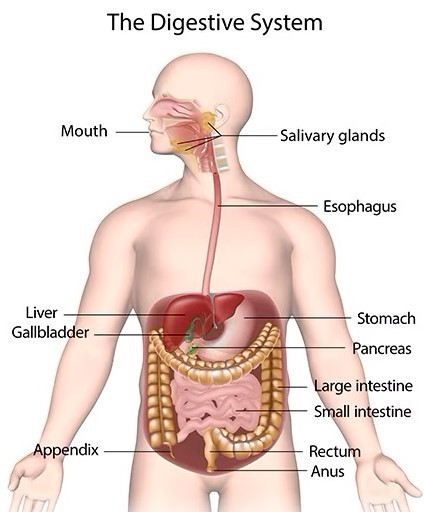 form chyme and carried to the small intestine, a 22 feet long coiled tube, 3½ times the length of our body, also called small bowel. Water and nutrients are absorbed by the mucosa and digestive enzymes of small intestine and undigested elements are sent to the large intestine or colon. The absorption process is completed here and wastes are eliminated through the rectum and anus. The associated organs liver, pancreas, and gall bladder help in this digestive process. Thus, gut is not just a passage but hosts a full-fledged system of ingestion, digestion, absorption, assimilation, and defecation of waste.3,4 It is also the most underrated supporting “organ”, also called the second brain, that gives us the proverbial “gut feeling”!
form chyme and carried to the small intestine, a 22 feet long coiled tube, 3½ times the length of our body, also called small bowel. Water and nutrients are absorbed by the mucosa and digestive enzymes of small intestine and undigested elements are sent to the large intestine or colon. The absorption process is completed here and wastes are eliminated through the rectum and anus. The associated organs liver, pancreas, and gall bladder help in this digestive process. Thus, gut is not just a passage but hosts a full-fledged system of ingestion, digestion, absorption, assimilation, and defecation of waste.3,4 It is also the most underrated supporting “organ”, also called the second brain, that gives us the proverbial “gut feeling”!
2. Importance of a healthy gut
2.1 Gut flora: At birth gut is sterile with hardly any microbes. Gradually, colonisation begins as it collects both good and bad from all the microorganisms in the environment creating a sophisticated, complex, microscopic world of trillions of bacteria called “the microbiome”, also referred to as “microbiota” interchangeably. It includes some viruses, fungi, and parasites too and is found in large numbers in the intestines. The 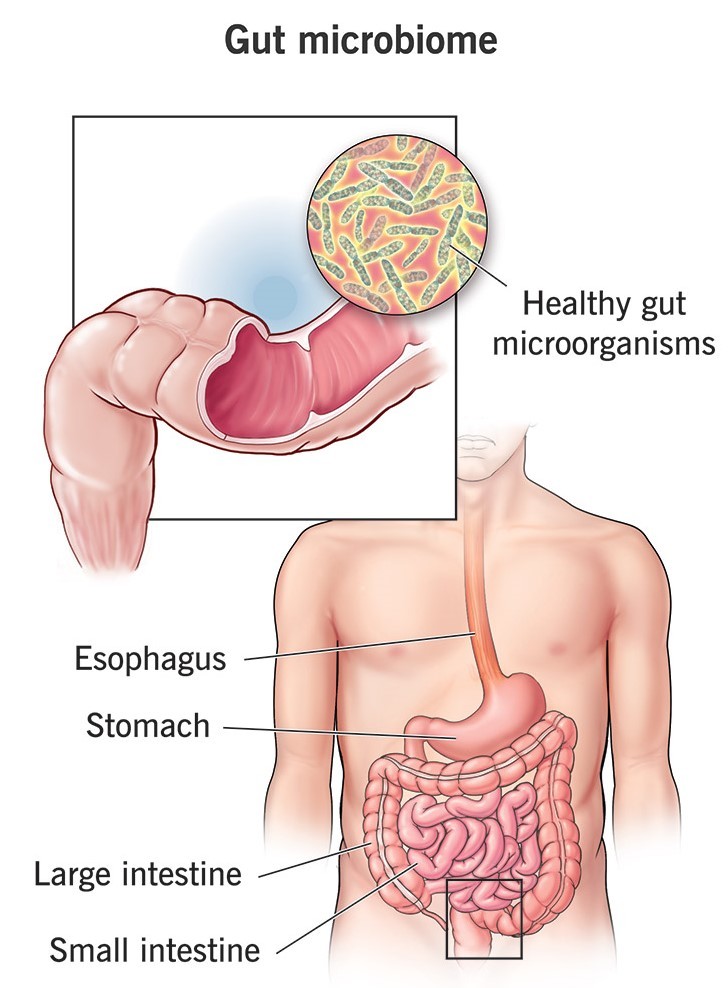 quality of the microbiome formed in the first few years of life depends on genetics, maternal microbiota, normal vaginal delivery (rather than a caesarean section), and breast feeding.5 Primary microbiota acquired in infancy build better immunity. They also become instrumental in determining the quality of adult microbiota, though they keep evolving throughout life in response to diet and environmental exposure playing a pivotal role in both health and disease.6
quality of the microbiome formed in the first few years of life depends on genetics, maternal microbiota, normal vaginal delivery (rather than a caesarean section), and breast feeding.5 Primary microbiota acquired in infancy build better immunity. They also become instrumental in determining the quality of adult microbiota, though they keep evolving throughout life in response to diet and environmental exposure playing a pivotal role in both health and disease.6
2.2 How microbiome works and benefits our body! In a healthy person the host gut cells and the resident bacteria coexist peacefully in a symbiotic relationship where both benefit from one another. The human intestine provides nutrients to the bacteria which in turn aid in digestion, absorption, and other processes. They break down compounds, synthesise amino acids and certain vitamins including B-vitamins and vitamin K. The key enzymes needed to form vitamin B12 are synthesised by the gut bacteria, not by plants or animals.6 They also aid in the metabolism of carbohydrates in the colon. Sugar gets quickly absorbed in the upper part of the small intestine. Complex carbs like starch and fibre travel down to large intestine where the microbiota break them down with their digestive enzymes. Indigestible fibres get fermented and release short chain fatty acids (SCFA) that lower the pH of the colon limiting the growth of harmful bacteria. SCFA in the gut can enhance muscle function, prevent chronic diseases including cancer and bowel disorders, and help in treating ulcerative colitis, Crohn’s disease, and antibiotic-associated diarrhoea. Gut bacteria also metabolise the bile in our intestines sent by the liver to help digest fats.6
The communication system between the gut and the brain enables the intestinal microbiota to determine our mental health. 95% of body’s serotonin, the mood boosting hormone, is produced by the gut bacteria. Stress is known to influence the composition of the microbiota which in turn can adversely affect our hormonal and nervous system.7
Further, 80% of our immune system is located in the gut closely linked with our metabolic systems too. Gut bacteria stimulate and train the immune system to respond proportionately to “antigens” (unrecognised substance or organism).8 Allergic infants and young children have been found to have a different composition of intestinal bacteria than those who do not develop allergies.5
A clean and healthy gut will thus ward off harmful pathogens, develop and modulate the immune system, prevent allergies, infections, and diseases, and take care of overall health
2.3 Factors that encourage good gut flora and health: A robust gut has a healthy diversity of microorganisms where no single bacteria, virus, or fungus dominates. This can be ensured through a proper diverse diet.
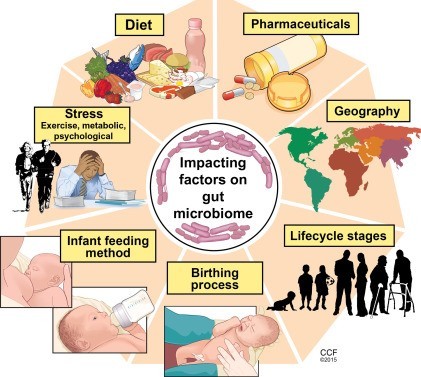 Fibre rich foods like vegetables, fruits, whole grains, beans and legumes, nuts and seeds, with a good combination of macro and micronutrients are important. Complementing foods like rice and beans, pasta with cheese, pita bread and hummus, peanut butter on toast provide all the amino acids.
Fibre rich foods like vegetables, fruits, whole grains, beans and legumes, nuts and seeds, with a good combination of macro and micronutrients are important. Complementing foods like rice and beans, pasta with cheese, pita bread and hummus, peanut butter on toast provide all the amino acids.
Prebiotics, naturally present in many plant foods, serve as food for good gut bacteria and nurture them. All prebiotics are fibre but all fibre rich foods are not prebiotics. They include fruits like apples, bananas, vegetables like raw garlic, onions, leeks, asparagus, artichokes, cabbage, jicama or Mexican turnip, peas, dandelion greens, whole grains like wheat, oats, rye, barley, quinoa, amaranth, corn, beans and legumes, flax seeds, chia seeds, and walnuts.9
Probiotics are live beneficial microbiota found in fermented foods like unprocessed yogurt with active or live culture, pickled vegetables; soy based tempeh, miso (rich in B-vitamins, esp. B12) and natto, kimchi and sauerkraut made from vegetables, esp. cabbage, kefir (a milk drink called champagne of the dairy world), and fermented tea kombucha.10 Fermented and steamed foods like Indian Idlis and dhokla are still considered beneficial though there are varied views whether probiotics survive steaming or cooking!
Hydration: Stay hydrated with plenty of pure water and fresh juicy fruits and vegetables.
2.4 Factors that cause imbalance and increase unhealthy gut microbiome: Regular movement of our bowels ensure turnover of microorganisms. The movement of food and waste through the GI tract distributes different microbes into different places along the way. If elimination is faster, unhealthy ones cannot thrive. The balance gets disturbed by certain diets, infectious illness, prolonged use of antibiotics or any other medication, too little sleep, and high stress levels. Foods that are processed or high in sugar help unhealthy microorganisms to flourish. Environmental toxins like alcohol, tobacco, smoke, and other pollutants, and pesticides prevent good microbes from thriving.8,11,12
3. Symptoms of imbalance in gut bacteria (gut dysbiosis)
Dysbiosis is lack of diversity and imbalance of microbiome. Symptoms are digestive issues like, bad breath, gas with pain, bloated stomach, heartburn, acidity, acid reflux, poor digestion, lower abdominal pain, diarrhoea, constipation, any change in bowel habits, lack of a sense of well-being, sudden onset of food intolerances, unexplained fatigue, mood disorders like anxiety and depression, or weight gain, sugar cravings, skin rash or allergies, and sleep disorders.11,13 If there is no other medical condition for these symptoms, it could be related to an unhealthy gut and intake of excess processed foods.
Imbalance of normal gut bacteria can cause inflammatory bowel disease (IBD) and irritable bowel syndrome (IBS). Its wider systemic manifestations are obesity, type-2 diabetes, and atopy; may also lead to Parkinson’s or Alzheimer’s disease.5
One may know the composition of one’s gut microbiome, but enough research has not been done to reveal how different types of gut bacteria affect our health. But infections and bacterial overgrowth can be checked through blood, stool, or breath test, esp. if the imbalance is visible and persistent.8
4. Tips to increase, maintain, or restore good gut bacteria
- Eat slowly, chewing thoroughly and attentively, fresh wholesome locally grown food and fermented foods.11 Also, ensure the food is hygienically prepared and partake in a worshipful manner as a precious gift from God, with gratitude and love, in silence, free from digital distractions. Also, avoid packaged and processed foods, or salted and sugary foods; do not overeat. Follow a good water regimen.
- Do not increase Prebiotic food suddenly; it will produce a lot of gas leading to flatulence and bloating. Start with a small amount to assess one’s tolerance and sensitivity and gradually increase the high fibre diet, which is a must as low fibre food can decrease good bacteria and encourage the growth of pathogenic bacteria.6
- Observe, to start with, at least 12 hours of fasting through night to aid digestion and detoxify at a cellular level. Observe a time restricted eating schedule during the day in tune with the natural circadian rhythm.14 Ensure first intake of any drink (other than water) after sunrise is after 7am and the last intake is by sunset, latest by 7pm. Can decrease gradually the eating window time from 12 hours to at least 10 hours. Coupled with timely sleeping schedule by 10pm and early rising at least an hour before sunrise, this discipline will help build up good gut bacteria. (Research indicates that such time restricted eating rhythm, or intermittent fasting as popularly known, gives rest to the digestive process and allows cyclical healing of the intestinal mucosa involving removal of old cells and regeneration of new cells).15
- To defecate, sit properly in a squatting style or replicate that position by using a small foot stool in pedestal toilets or by inclining the upper body forward slightly and putting the feet on a low footrest in
 front of the toilet! This will relax the muscles and facilitate smooth bowel movement.4
front of the toilet! This will relax the muscles and facilitate smooth bowel movement.4
Final word: You are what you eat, when you eat, and how much you eat! A healthy whole foods diet with pre- and pro-biotics and adequate hydration with an appropriate lifestyle is the key to a healthy gut and a healthy life!
References and Links
- Sathya Sai Baba Divine Discourse on “Food and Health” on 21 Sept 1979: https://sssbpt.info/ssspeaks/volume14/sss14-31.pdf
- Sathya Sai Baba Divine Discourse on “Well or Ill” 26 Sept 1965: https://sssbpt.info/ssspeaks/volume05/sss05-38.pdf
- https://www.niddk.nih.gov/health-information/digestive-diseases/digestive-system-how-it-works#
- Gut, The Inside Story of Our Body’s Most Underrated Organ, Giulia Enders, published by Greystone Books, 2015.
- Human gut microbiome in health and disease: https://ncbi.nlm.nih.gov/pmc/articles/PMC4566439/
- https://www.hsph.harvard.edu/nutritionsource/microbiome/
- Impact of Gut microbiome: https://www.apa.org/monitor/2012/09/gut-feeling
- https://my.clevelandclinic.org/health/body/25201-gut-microbiome
- Prebiotics: https://www.chop.edu/health-resources/food-medicine-prebiotic-foods
- Probiotics: https://healthline.com/nutrition/11-super-healthy-probiotic-foods
- https://www.betterhealth.vic.gov.au/health/healthyliving/gut-health
- https://www.ncbi.nlm.nih.gov/pmc/articles/PMC6699480/
- Imbalance/Dysbiosis: https://my.clevelandclinic.org/health/diseases/dysbiosis
- Circadian rhythm for health: https://www.youtube.com/watch?v=fciGNBN0nKM
- Right way of intermittent fasting: https://www.youtube.com/watch?v=0P2lz45rFCA
2. Workshops & Seminar
2.1 AVP workshop in Spanish, Montevideo, Uruguay 6-7 April 2024
Practitioner 01001 conducted her maiden workshop in Spanish where two committed students from Argentina made a long journey to Uruguay and became AVPs after completing their e-course and qualifying at the virtual course held from 19 to 23 Feb 2024. She was supported by two senior teachers11442 & 10375. Dr Aggarwal addressed the participants and answered their queries during the 2-day workshop. The newly qualified practitioners03618 & 03619 felt truly inspired and deeply connected with the pure spirit of Vibrionics seva. Grateful for this immense gift, they returned to their cities ready to begin their journey on this wonderful path that Swami has laid before them.

2.2 AVP workshop, Puttaparthi 26-28 April 2024
Eight enthusiastic participants of the April batch qualified during the virtual course and became AVPs11661-11668 and proud receivers of the blessed 108CC box on 27 April. Throughout the course, they were eager to understand the subject and the nuances of practice, delighted the faculty by raising pertinent and perceptive questions. They had the opportunity to interact with patients one-to-one, learnt how gently to get details from patients, plan and make their remedies, and follow up. Dr Aggarwal shared at the valedictory session his personal experiences in treating patients, how simple and potent vibrionics is, the importance of faith and the need to stay connected with Swami, and how to tame the mind away from worldly attractions. Practitioner 11614 who had years of experience as a nurse in Swami’s hospital gave some first aid tips in situations such as fainting, epileptic or heart attack, snake bite, bleeding, or hypoglycaemia in a diabetic. Their joyful faces and expressions of gratitude while leaving reflected their readiness to plunge into this seva!
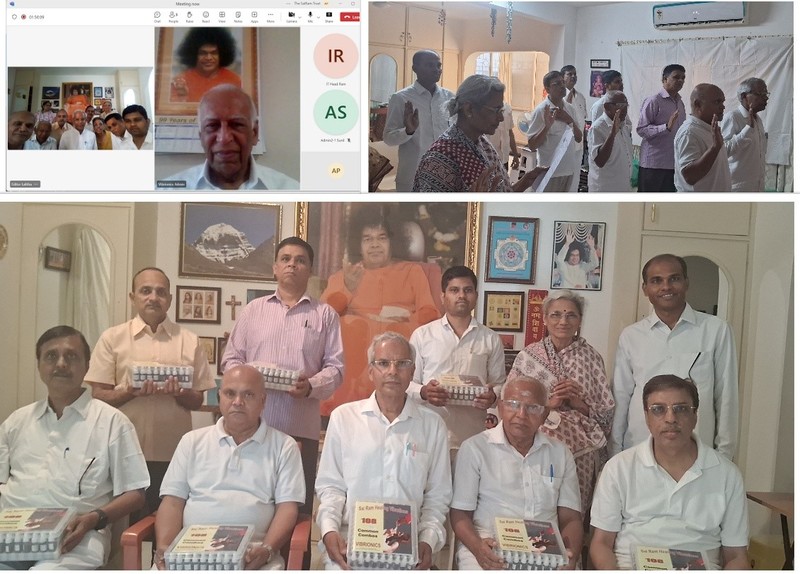
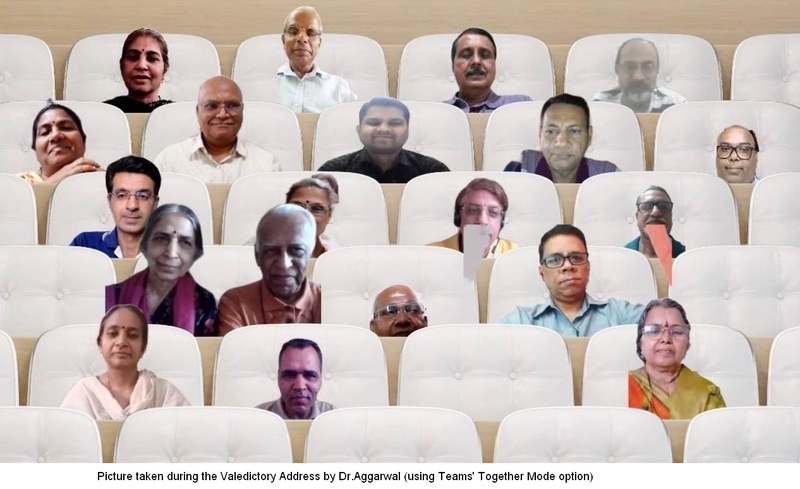
2.3 Sai Vibrionics Practitioners' Meeting, UK Midland Group, 21 January 2024
This half-a-day virtual seminar was marked by enlightening presentations by Practitioners 02802 & 00534 on dementia and managing the endocrine system through hormonal balance. The participants also learnt the techniques to manage pain, including using bay leaves for healing, from a visiting faculty Dr Pabani. The meeting ended with expression of gratitude for all those devoted to Vibrionics in multiple ways. The material presented are available at our practitioners site (Forms > Download option).
3. Camps & Clinics
New Sai Vibrionics Centre inaugurated, 7 April 2024, AP.
With the Divine Blessings and Grace of our beloved Bhagawan Sri Sathya Sai Baba, a Sai Vibrionics Wellness Centre was inaugurated on 7 April 2024 at the Sri Sathya Sai Mandiram, Haripalem, Atchutapuram, Anakapalli District, Andhra Pradesh. This well attended programme by the members of local samitis and people around was charged with devotional prayers and bhajans, followed by an inspirational talk by a senior practitioner11567, and a question-answer session on Vibrionics. It concluded with Aarti and Prasadam, but not before distribution of 54 IB bottles to the visitors. A team of two practitioners 11634 & 18009 will treat patients at this centre every 1st Sunday of the month from 10:00 am to 12:00 pm starting from 5 May 2024.

4. In Memoriam
Sri Mahendra Popat 00298…UK from London left for his heavenly abode at the age of 75 on 24 March 2024. He was one of the earliest practitioners and helped greatly in establishing vibrionics in the UK by organising meetings/workshops in London in those early days. His elder sister Practitioner 02821, inspired by him to take up vibrionics, has this to say about him ‘His detachment was truly amazing! He had strength and courage like no one, his seva was truly selfless’; these sentiments are shared by all those who crossed his path. He was always focussed on healing seva and would come to Puttaparthi for several months at a time to treat patients. Since his stroke in 2020 he was not so active but was always ready to help patients and practitioners with advice. He will be sadly missed by his family friends and colleagues. May his departed soul rest in peace and eternal Bliss!

